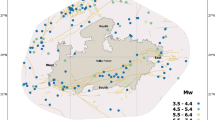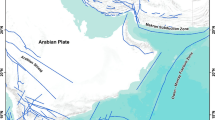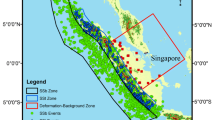Abstract
This study aims to build on the existing knowledge and improve the overall PSHA results by modifying source, path and site characteristics for Bangladesh. Firstly, six potential seismotectonic zones have been re-defined based on the recent study of Wang et al. (J Geophys Res Solid Earth 119:3576–3822, 2014) and Nath and Thingbaijam (J Seismol 15(2):295–315, 2011), and the updated earthquake catalogue has been declustered using two methods. Important source parameters, such as recurrence b-values and maximum magnitudes, have been determined using the Maximum Likelihood and cumulative moment methods, respectively, and their uncertainties have been addressed using a logic-tree approach. Secondly, based on literature review and studies in neighboring countries, suitable GMPEs have been selected for the seismic zones and the uncertainties have been addressed using a logic tree approach. A significant novelty of the study lies in the consideration of the site effects by integrating Vs30 values throughout the country. The ground motions—PGA and SA (at 0.2, 1.0 and 2.0 s) are computed using GEM’s OpenQuake and presented in form of hazard maps for 2% and 10% probabilities of exceedance in 50 years as well as mean hazard curves and uniform hazard spectra. Disaggregation for capital city Dhaka has also been carried out to show the hazard contributions of magnitude–distance pairs. The spatial distribution of PGA and SA are found remarkably higher than previous findings, likely due to differences in parameters and uncertainties. The results show a marked increase (by almost 20%) in the observed ground motions with respect to those carried out previously by uniformly characterizing the whole country as a firm rock.

Source: https://earthexplorer.usgs.gov/. Adopted from Wang et al. (2014)















Similar content being viewed by others
References
Abrahamson, N. A., & Silva, W. (1997). Empirical response spectral attenuation relations for shallow crustal earthquakes.
Abrahamson, N., & Silva, W. (2008). Summary of the Abrahamson & Silva NGA ground-motion relations. Earthquake Spectra,24(1), 67–97. https://doi.org/10.1193/1.2924360.
ADPC and OYO. (2009). Time-Predictable fault Modeling of Bangladesh. Bangladesh: CDMP II, Ministry of Disaster Management and Relief. https://doi.org/10.1007/s13398-014-0173-7.2.
Aki, K. (1965). Maximum Likelihood Estimate of b in the formula log N = a - b M and its Confidence Limits. Bulletin of the Earthquake Research Institute,65, 237–239.
Akkar, S., & Bommer, J. (2010). Empirical equations for the prediction of PGA, PGV, and spectral accelerations in Europe, the Mediterranean Region, and the Middle East extended-source crustal earthquake scenarios. https://doi.org/10.1785/gssrl.81.2.195.
Al-hussaini, T. M., & Al-noman, M. N. (2010). Probabilistic estimates of PGA and spectral acceleration in Bangladesh.
Al-hussaini, T. M., Al-noman, M. N., & Chowdhury, I. N. (2015) Seismic hazard assessment for Bangladesh—old and new perspectives.
Ali, M. H., & Choudhury, J. R. (1994). Seismic zoning of Bangladesh. In International seminar on recent developments in earthquake disaster mitigation, Dhaka. https://doi.org/10.1023/B:VISI.0000022288.19776.77.
Ambraseys, N. N. (2004). Three little known early earthquakes in India. Current Science,86(4), 506–508.
Ansary, M. A., & Sharfuddin, (2002). Proposal for a new seismic zoning map for Bangladesh. Journal of Civil Engineering, Institution of Engineers Bangladesh,30(2), 77–89.
Atkinson, G. M., & Boore, D. M. (1995). Ground-motion relations for eastern north America. Bulletin of the Seismological Society of America,85(1), 17–30. https://doi.org/10.1785/0120050245.
Atkinson, G. M., & Boore, D. M. (2003). Empirical ground-motion relations for subduction-zone earthquakes and their application to Cascadia and other regions. Bulletin of the Seismological Society of America,93(4), 1703–1729. https://doi.org/10.1785/0120020156.
Atkinson, G. M., & Boore, D. M. (2006). Earthquake ground-motion prediction equations for eastern North America. Bulletin of the Seismological Society of America. https://doi.org/10.1785/0120050245.
Atkinson, G. M., & Boore, D. M. (2011). Modifications to existing ground-motion prediction equations in light of new data. Bulletin of the Seismological Society of America,101(3), 1121–1135. https://doi.org/10.1785/0120100270.
Avouac, J.-P. (2015). Mountain building: From earthquakes to geologic deformation, treatise on geophysics. Oxford: Elsevier B.V. https://doi.org/10.1016/B978-0-444-53802-4.00120-2.
Bangladesh National Building Code. (2015). Housing and Building Research Institute.
Bender, B. (1983) Maximum likelihood estimation of b values for magnitude grouped data. Bulletin of the Seismological Society of America.
Bilham, R. (2004). Historical studies of earthquakes in India. Annals of Geophysics,47, 1–26.
Bommer, J. J., & Abrahamson, N. A. (2006). Why do modern probabilistic seismic-hazard analyses often lead to increased hazard estimates? Bulletin of the Seismological Society of America. https://doi.org/10.1785/0120060043.
Brandt, M. B. C., & Saunders, I. (2011). New regional moment tensors in South Africa. Seismological Research Letters,82(1), 69–80. https://doi.org/10.1785/gssrl.82.1.69.
Campbell, K. W., & Bozorgnia, Y. (2008). NGA ground motion model for the geometric mean horizontal component of PGA, PGV, PGD and 5% damped linear elastic response spectra for periods ranging from 0.01 to 10 s. Earthquake Spectra,24(1), 139–171. https://doi.org/10.1193/1.2857546.
Chapman, M. C. (1995). A probabilistic approach to ground-motion selection for engineering design. Bulletin of the Seismological Society of America.
Chiou, B. S. J., & Youngs, R. R. (2008). An NGA model for the average horizontal component of peak ground motion and response spectra. Earthquake Spectra,24(1), 173–215. https://doi.org/10.1193/072813EQS219M.
Chiou, B.J.S., & Youngs, R. (2014). Update of the chiou and youngs NGA model for the average horizontal component of peak ground motion and response spectra. Earthquake Spectra,30(3), 1117–1153.
Comprehensive Disaster Management Programme (CDMP). (2012). Earthquake risk and damage assessment and subsequent development of scenario-based contingency planning for Rangpur, Dinajpur, Mymensingh, Tangail, Bogra and Rajshahi Municipalities/City Corporations and Detailed Building Inventory of the Said Towns Including Dhaka and Chittagong City Corporation.
Cornell, C. A. (1968). Engineering seismic risk analysis. Bulletin of the Seismological Society of America,58(5), 1583–1606. https://doi.org/10.1016/0167-6105(83)90143-5.
Douglas J., Cotton F., Abrahamson N.A., Akkar S., Boore D.M., & Alessandro D.C. (2013). Pre-selection of ground motion prediction equations. Global earthquake model. Version 1.0.
Garnder, J. K., & Knopoff, L. (1974). Bulletin of the seismological Society of America. Bulletin of the Seismological Society of America,64(5), 1271–1302. https://doi.org/10.1785/0120160029.
Geological Survey of Bangladesh (GSB). (1979). Final report by the Committee of Experts on Earthquake Hazard Minimization.
Ghosh, B. et al. (2012). Seismic hazard assessment in India. In 15th world conference on earthquake engineering. http://www.iitk.ac.in/nicee/wcee/article/WCEE2012_2107.pdf.
Gregor, N., et al. (2014). Comparison of NGA-West2 GMPEs. Earthquake Spectra,30(3), 1179–1197. https://doi.org/10.1193/070113EQS186M.
Gutenberg, B., & Richter, C. F. (1944). Frequency of earthquakes in California. Bulletin of the Seismological Society of America,34, 185–188.
Hanks, T. C., & Kanamori, H. (1979). A moment magnitude scale. Journal of Geophysical Research B Solid Earth,19, 2348–2350. https://doi.org/10.1029/jb084ib05p02348.
Heaton, T. H., & Tajima, F. (1986). Estimating ground motions using recorded accelerograms. Surveys in Geophysics,8, 25–83.
Islam, M. S. et al. (2010). Attenuation of earthquake intensity in Bangladesh. In Proceedings, 3rd International Earthquake Symposium, Bangladesh, Dhaka, March 5–6, 2010.
Joyner, W. B., & Boore, D. M. (1981). Peak horizontal acceleration and velocity from strong-motion records including records from the 1979 imperial valley, california, earthquake. Bulletin of the Seismological Society of America,71(6), 2011–2038.
Kaklamanos, J., Baise, L. G., & Boore, D. M. (2011). Estimating unknown input parameters when implementing the NGA ground-motion prediction equations in engineering practice. Earthquake Spectra,27(4), 1219–1235. https://doi.org/10.1193/1.3650372.
Lin, P., & Lee, C. (2008). Ground-motion attenuation relationships for subduction-zone earthquakes in Northeastern Taiwan. Bulletin of the Seismological Society of America,98(1), 220–240. https://doi.org/10.1785/0120060002.
Makropoulos, K. C., & Burton, P. W. (1983). ‘Seismic risk of circum-pacific earthquakes I. Strain energy release. Pure and Applied Geophysics. https://doi.org/10.1007/BF02590137.
Musson, R. M. W. (1999). Probabilistic seismic hazard maps for the north Balkan region. Annals of Geophysics. https://doi.org/10.4401/ag-3772.
Nath, S. K. (2012). Ground-motion predictions in Shillong region, northeast India Ground-motion predictions in Shillong region, northeast India’. Journal of Seismology. https://doi.org/10.1007/s10950-012-9285-8.
Nath, S. K., & Thingbaijam, K. K. S. (2011). Peak ground motion predictions in India: An appraisal for rock sites. Journal of Seismology,15(2), 295–315. https://doi.org/10.1007/s10950-010-9224-5.
Nath, S. K., & Thingbaijam, K. K. S. (2012). Probabilistic Seismic Hazard Assessment of India. Seismological Research Letters,83(1), 135–149. https://doi.org/10.1785/gssrl.83.1.135.
Noor, M. A., Yasin, M. , & Ansary, M. A. (2005) Seismic hazard analysis of Bangladesh. In First Bangladesh earthquake symposium. Dhaka.
Ordaz, M., et al. (2013). CRISIS2008: A flexible tool to perform probabilistic seismic hazard assessment. Seismological Research Letters. https://doi.org/10.1785/0220120067.
Scordilis, E. M. (2006). Empirical global relations converting MSand mbto moment magnitude. Journal of Seismology,10(2), 225–236. https://doi.org/10.1007/s10950-006-9012-4.
Silva, V., et al. (2014). Development of the OpenQuake engine, the Global Earthquake Model’s open-source software for seismic risk assessment. Natural Hazards,72(3), 1409–1427. https://doi.org/10.1007/s11069-013-0618-x.
Sipkin, S. A. (2003). A correlation to body-wave magnitude mb based on moment magnitude Mw. Seismological Research Letters,74(6), 739–742.
Steckler, M. S., et al. (2016). Locked and loading megathrust linked to active subduction beneath the Indo-Burman Ranges. Nature Geoscience,9(8), 615–618. https://doi.org/10.1038/ngeo2760.
Stepp, J. C. (1972). Analysis of completeness of the earthquake sample in the Puget Sound area and its effect on statistical estimates of earthquake hazard. In Proceedings of the 1st international conference on microzonazion, Seattle, Vol. 2, (July), pp. 897–910.
Strasser, F. O., Arango, M. C., & Bommer, J. J. (2010). Scaling of the source dimensions of interface and Intraslab subduction-zone earthquakes with moment magnitude. Seismological Research Letters,81(6), 941–950. https://doi.org/10.1785/gssrl.81.6.941.
Tavakoli, B., & Pezeshk, S. (2005). Empirical-stochastic ground motion prediction for Eastern North America. Bulletin of the Seismological Society of America,95, 2283–2296.
U.S. Geological Survey. (2018). USGS. https://earthquake.usgs.gov/earthquakes/search/. Accessed 13 June 2018.
Uhrhammer, R. (1986). Characteristics of northern and central California seismicity. In: Earthquake Notes 57.1, page 21 (cited on pages 22, 23).
Urban Development Directorate (UDD). (2018). Geological study and seismic hazard assessment for the preparation of the development plan for Mirsharai and Kuakata Upazilla.
Wang, Y. (2014). Active tectonic and earthquake Myanmar region. Journal of Geophysical Research Solid Earth,20, 3576–3822. https://doi.org/10.1002/2013jb010762.received.
Wang, Y., et al. (2014). Active tectonic and earthquake Myanmar region. Journal of Geophysical Research Solid Earth,119, 3576–3822. https://doi.org/10.1002/2013JB010762.
Weatherill, G. A. (2014). OpenQuake hazard modeller’ s toolkit-user guide.
Youngs, R. R., Chiou, S. J., Silva, W. J., & Humphrey, J. R. (1997). Strong ground motion attenuation relationships for subduction zone earthquakes.pdf. Seismological Research Letters,68(1), 58–73.
Yu, W., & Sieh, K. (2013). Active tectonic features that pose a seismic threat to Bangladesh, A report published by Comprehensive Disaster Management Programme (CDMP). Dhaka.
Zhao, J. X., et al. (2016). Ground-motion prediction equations for subduction slab earthquakes in Japan using site class and simple geometric attenuation functions. Bulletin of the Seismological Society of America,106(4), 1–17. https://doi.org/10.1785/0120150056.
Author information
Authors and Affiliations
Corresponding author
Additional information
Publisher's Note
Springer Nature remains neutral with regard to jurisdictional claims in published maps and institutional affiliations.
Appendices
Appendix 1






Appendix 2


Appendix 3
Average shear wave (Vs30) values at different site locations
Long | Lat | Vs30 | Long | Lat | Vs30 |
|---|---|---|---|---|---|
89.37351 | 24.85611 | 263 | 90.50646 | 24.70862 | 188 |
89.37821 | 24.85244 | 223 | 90.48071 | 24.66993 | 185 |
89.38115 | 24.84863 | 224 | 90.07743 | 23.63394 | 156 |
89.36895 | 24.86125 | 243 | 90.12161 | 23.61735 | 148 |
89.13993 | 24.85871 | 264 | 90.20647 | 23.62696 | 145 |
89.37736 | 24.82160 | 239 | 90.16812 | 23.34572 | 160 |
89.36439 | 24.84216 | 254 | 90.87897 | 23.98158 | 153 |
89.36459 | 24.85270 | 279 | 90.82998 | 24.03064 | 198 |
89.38171 | 24.83721 | 236 | 92.08725 | 21.44789 | 201 |
89.36023 | 24.86636 | 232 | 92.11755 | 21.37114 | 253 |
89.35992 | 24.88673 | 242 | 92.11636 | 21.46377 | 181 |
89.36504 | 24.83427 | 238 | 92.06448 | 22.53408 | 153 |
89.38101 | 24.82901 | 279 | 89.52582 | 25.16704 | 164 |
89.35303 | 24.82963 | 215 | 89.58458 | 25.10831 | 152 |
88.65151 | 25.64451 | 232 | 90.16812 | 23.34572 | 160 |
88.62206 | 25.64237 | 188 | 89.53075 | 24.87858 | 165 |
88.62054 | 25.62871 | 221 | 89.57335 | 24.89326 | 169 |
88.62655 | 25.64922 | 219 | 89.55868 | 24.98045 | 155 |
88.62847 | 25.61205 | 238 | 89.46803 | 24.99597 | 185 |
88.63723 | 25.63992 | 256 | 90.42106 | 24.74833 | 185 |
88.64479 | 25.66449 | 314 | 90.42473 | 24.74163 | 125 |
88.65336 | 24.35568 | 247 | 90.43113 | 24.73216 | 154 |
88.62439 | 24.36004 | 215 | 90.43497 | 24.71909 | 255 |
88.61966 | 24.40818 | 159 | 90.42564 | 24.71931 | 143 |
88.58221 | 24.37623 | 244 | 90.36881 | 24.77575 | 181 |
88.56844 | 24.39346 | 201 | 90.37660 | 24.77430 | 173 |
88.59560 | 24.36341 | 181 | 90.48681 | 24.73591 | 214 |
89.89567 | 24.24692 | 209 | 90.38451 | 24.76567 | 180 |
89.92429 | 24.26897 | 184 | 90.40125 | 24.74600 | 198 |
89.92853 | 24.22441 | 215 | 90.36217 | 23.88536 | 200 |
89.89463 | 24.25761 | 236 | 90.48583 | 23.82778 | 127 |
89.90158 | 24.23534 | 192 | 90.34372 | 23.76539 | 174 |
89.90672 | 24.24355 | 169 | 90.40722 | 23.80056 | 246 |
90.60028 | 24.68912 | 179 | 90.39028 | 23.71028 | 175 |
90.50244 | 23.70550 | 223 | 91.54239 | 22.83615 | 199 |
91.49581 | 22.89871 | 179 | 91.50001 | 22.85378 | 183 |
90.50244 | 23.70550 | 223 | 91.54239 | 22.83615 | 199 |
91.75678 | 22.39136 | 195 | 91.51746 | 22.81188 | 209 |
91.85628 | 22.42250 | 125 | 91.48335 | 22.82661 | 183 |
91.81572 | 22.38317 | 420 | 91.59575 | 22.7794 | 269 |
91.85406 | 22.33100 | 160 | 91.53249 | 22.78397 | 193 |
91.82386 | 22.25653 | 199 | 91.53351 | 22.74951 | 180 |
91.79664 | 22.23794 | 156 | 91.58926 | 22.74442 | 178 |
91.94622 | 24.91925 | 256 | 91.62035 | 22.7002 | 192 |
91.92872 | 24.86008 | 172 | 91.60059 | 22.67191 | 182 |
91.86442 | 24.91831 | 341 | 91.5464 | 22.89774 | 235 |
91.85564 | 24.86856 | 140 | 90.61066 | 24.63043 | 179 |
91.88667 | 24.91022 | 212 | 90.50244 | 23.70550 | 223 |
91.79564 | 24.90081 | 157 | 90.122042 | 21.822277 | 159 |
88.73273 | 23.78366 | 241 | 90.405833 | 21.908114 | 173 |
88.82253 | 23.79642 | 203 | 90.083894 | 21.98446 | 148 |
88.76714 | 23.79047 | 229 | 90.22015 | 21.98503 | 149 |
88.82855 | 23.81640 | 173 | 90.418347 | 22.025535 | 154 |
88.73260 | 23.82609 | 193 | 89.927283 | 22.067503 | 154 |
88.74858 | 23.81835 | 227 | 90.051524 | 22.044112 | 158 |
88.81804 | 23.82508 | 173 | 90.186166 | 22.059275 | 137 |
88.79932 | 23.82355 | 201 | 90.408955 | 22.168115 | 162 |
88.71098 | 23.83142 | 216 | 90.233098 | 22.141493 | 165 |
88.76802 | 23.84709 | 182 | 90.31988 | 22.05873 | 134 |
88.65115 | 23.85518 | 228 | 90.015177 | 22.177767 | 134 |
88.85149 | 23.86646 | 202 | 90.122003 | 22.155764 | 147 |
88.78759 | 23.87305 | 178 | 90.322332 | 22.247763 | 128 |
88.67374 | 23.87088 | 233 | 90.45629 | 22.22561 | 139 |
88.80393 | 23.88907 | 217 | 90.275292 | 21.994316 | 169 |
88.76061 | 23.90297 | 192 | 90.44303 | 24.71977 | 181 |
88.71700 | 23.89365 | 237 | 90.39331 | 24.75675 | 185 |
88.85344 | 23.91934 | 218 | 88.721173 | 24.306128 | 220 |
88.75707 | 23.94155 | 204 | 88.728859 | 24.356102 | 199 |
88.79390 | 23.95878 | 194 | 88.677473 | 24.415114 | 216 |
88.77811 | 23.82896 | 234 | 88.606420 | 24.362110 | 199 |
88.73162 | 23.85178 | 224 | 88.684705 | 24.346747 | 217 |
88.72510 | 23.89705 | 269 | 88.639558 | 24.381613 | 227 |
88.85581 | 23.91220 | 248 | 88.607687 | 24.396923 | 226 |
88.80393 | 23.88907 | 190 | 88.587194 | 24.408673 | 215 |
91.55832 | 22.93579 | 333 | 88.591944 | 24.380000 | 209 |
88.635400 | 24.405100 | 218 | 88.643311 | 24.457038 | 219 |
88.612640 | 24.467003 | 207 | 88.632226 | 24.436689 | 190 |
88.569700 | 24.370300 | 203 | 88.605666 | 24.40056 | 220 |
88.558712 | 24.442587 | 181 | 88.598998 | 24.378941 | 197 |
88.552316 | 24.391279 | 194 | 88.597518 | 24.451448 | 219 |
88.482410 | 24.370630 | 262 | 88.593071 | 24.400585 | 209 |
88.749009 | 24.342104 | 229 | 88.587622 | 24.366168 | 224 |
88.727314 | 24.345881 | 183 | 88.621069 | 24.359928 | 199 |
88.710272 | 24.331093 | 197 | 88.568198 | 24.414109 | 209 |
88.697216 | 24.408906 | 197 | 88.564457 | 24.391927 | 239 |
88.665829 | 24.382933 | 191 | 88.540286 | 24.387145 | 233 |
88.669956 | 24.422851 | 204 | 88.497604 | 24.372732 | 223 |
88.6478441 | 24.3635879 | 189 | 88.610092 | 24.344658 | 189 |
88.697382 | 24.380363 | 206 | 88.6327574 | 24.3661643 | 225 |
Rights and permissions
About this article
Cite this article
Haque, D.M.E., Khan, N.W., Selim, M. et al. Towards Improved Probabilistic Seismic Hazard Assessment for Bangladesh. Pure Appl. Geophys. 177, 3089–3118 (2020). https://doi.org/10.1007/s00024-019-02393-z
Received:
Revised:
Accepted:
Published:
Issue Date:
DOI: https://doi.org/10.1007/s00024-019-02393-z




